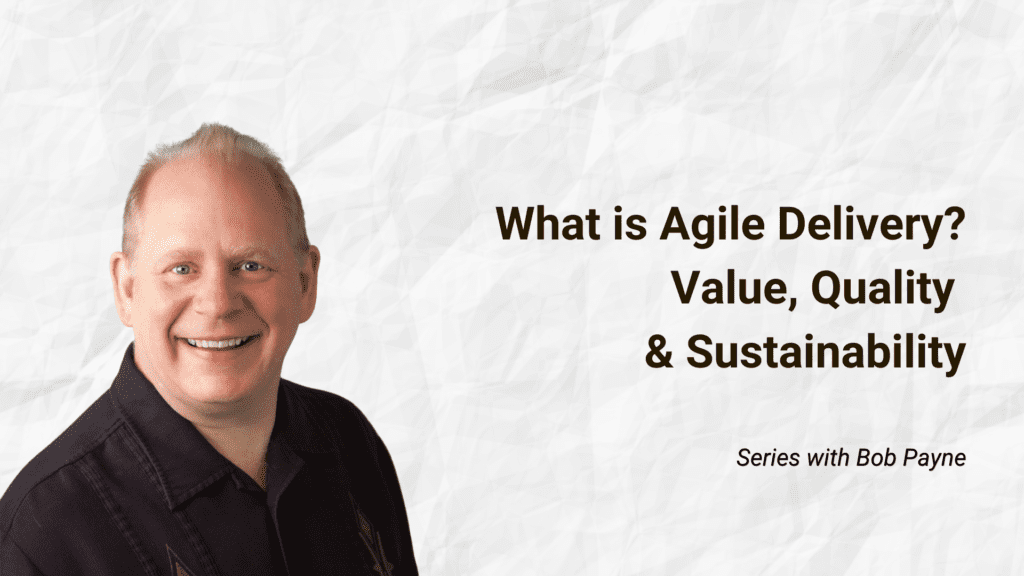What is Agile Delivery?
I’ve come to the conclusion that “Agile Delivery” means something different in each organization. The characteristics that I look for and strive for when I work with teams that are trying to improve their delivery are:
- Work needs to be iterative and incremental.
- Work needs to get feedback.
- We should find value in the marketplace to get better over time.
- We need to prove that the products/services we are delivering to our constituents work as intended.
Take a look at the work that you’re doing and look for these three components:
- Value
- Quality
- Sustainability
Whether you are using Scrum, SAFe®, Kanban or any other methodology, if you can show me that you’re delivering those three things – that is Agile delivery.
Value in Agile Delivery
What is value? You can’t take value out of the context in which it’s defined. I don’t mean to sound too abstract here, so let me give you a few examples.
- If I work at a startup, it might be growing my customer base so that I can prove to venture capitalists that I have something that is worth investing in.
- If I’m at a manufacturing firm, it could be increasing margins and lowering costs.
- If I’m a lawyer or work in the government, It’s compliance. It’s the ability to roll that out in an understandable way to whoever that policy needs to affect.
It doesn’t matter how valuable the idea is if I can’t deliver it. If I’ve got a million dollar idea that I won’t be able to realize for 500 years, the idea has zero value.
Make sure everyone on your team is aligned to the value of your product or service and make sure everyone understands how their day-to-day work contributes to that delivery of that value. Make the value flow through the system with discipline and continuously improve to get better and better over time.
Quality in Agile Delivery
Quality is an attribute of whatever you’re doing – a service you’re delivering, a product you’re building, research you’re doing. Value defines whether we’ve met the intent: whether we’ve produced something that is correct or appropriate to the task.
Again, this is situationally dependent on what we’re building:
- If I’m building a life critical system, like an implantable medical device, lives depend on the quality.
- The risk is very high if I make a mistake, so I need to have very high quality.
- If all I’m trying to do is have a conversation to figure out a solution, maybe the appropriate quality is going up to a white board and sketching some business process out with circles and arrows and a conversation.
- Very low quality, but there’s timed value that I’ve captured by doing it quickly. (You can always trade off quality for speed.)
I’ve seen way too many people gold-plating prototypes so they can put it in front of a user and have them go, “this is not what I want.” Maybe a sketch on a paper would have been appropriate.
So, when you think about quality – we’re looking at what is appropriate for the thing we are building. It is the people that we need to get involved to get aligned around what the appropriate quality is for this thing we are doing.
Sustainability in Agile Delivery
Companies like Toyota, Walmart and Amazon know that they’re playing the long game. Yes, they have quarterly returns they are trying to meet, but ultimately if they meet those returns and go out of business, then that’s not a viable model.
Businesses think about short-term milestones, short-term gains. And we’re seeing organizations move toward longer-term thinking so that they can maximize those longer-term returns rather than focusing just on the short-term.
Sustainability needs to be a primary concern when we’re looking at using Agile methods to deliver value and get it to flow to our marketplace at the appropriate quality. Sustainability requires continuous improvement so we make it easier to deliver things.
Obviously, there’s a business component to sustainability. Ask yourself these serious questions:
- Will we be in business next quarter?
- Will we be improving our performance in the marketplace?
- Will we stay the same or struggle and decline?
Sustainability also needs to be focused on human factors. We want our teams to be happy and viable to deliver value at the appropriate quality.
Are people engaged with the work that they do? Are they enjoying it? Are they going to work recharged rather than drained? Do they have the energy to innovate?
If they’re going home drained, quality and value delivery is going to taper off over time. It’s going to kill your business. We’ve seen this in many, many organizations as they struggle and decline. The environment gets less and less sustainable. Quality goes down. Value delivery goes down.
And the marketplace reacts as it should react: we don’t need your goods and services anymore.
Finding the balance of value flow, appropriate quality and sustainability is difficult and there is no one size fits all strategy. Dedicating the focus of all levels of the organization on the pursuit of these goals combined with the discipline and continuous improvement built into Lean and Agile methods is definitely the best way to find “Your Way” along this path.
With a lean mindset, we’ll be able to build better organizations that support great work and deliver great products and services to the marketplace.

